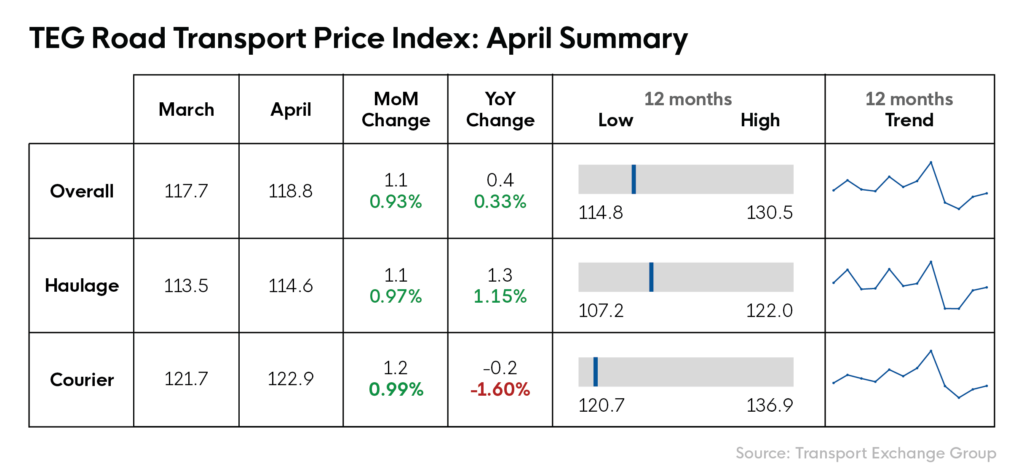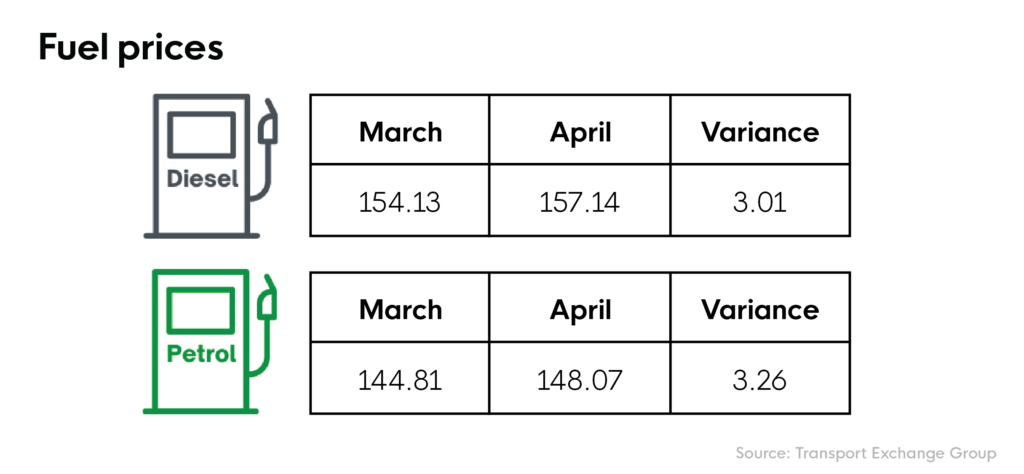Road Transport Price Index – April 24
2nd May 2024
Transport prices edge upwards in April, in line with the 2023 trend
The TEG index continues to climb following Easter and fuel prices follow suit.
Integra makes sense of the road transport landscape. Get more insight with Integra, TEG’s enterprise solution.
Index trends at a glance
April 2024 saw a further rise in the TEG Road Transport Index, following a low of 114.5 in February. The April index now stands at 118.8; 1.1 points and 0.93% higher than figures observed in March 2024. Year-on-year, however, the rise is only 0.33%, suggesting that current prices broadly reflect those seen at this time last year.
Haulage prices also rose by 1.1 points in March (0.97% month-on-month). This represents a slightly higher year-on-year jump of 1.15%.
Looking at the price index for couriers, the same pattern can be seen month-on-month. The index rose 1.2 points (0.99%) in April. Interestingly, year-on-year courier prices fell slightly by 0.2 index points. While this could be an isolated blip, the industry will, no doubt, keep a close eye on how courier prices move in May.
Given the general deflationary trend of the courier index since July 2023 and the latest DfT traffic data (which shows no increase in traffic volumes for light commercial vehicles), it could be that businesses have invested in surplus vans, driving courier prices down.


Industry pulse
While Easter Sunday fell at the end of March, the bank holidays meant the UK transport industry experienced one less working day in March and a second (Easter Monday) in April. The inevitable Easter rush no doubt shifted some deliveries earmarked for March into April, potentially impacting transport prices for both hauliers and couriers.
Meanwhile, the National Living Wage came into force on 1st April. It now stands at £11.44 an hour for those aged 21 and over. This is a 9.8% increase. While HGV truck drivers have already received wage increases above inflation, the National Living Wage could be significant for others in the logistics sector, such as warehouse staff.
Still, wage increases do not appear to be affecting transport prices significantly so far.
Fuel watch
For the third consecutive month, fuel prices continued to rise, though the price of diesel remained lower than a year ago.
Petrol prices experienced the steepest increase, rising by 3.26p per litre at the pump to £148.07. That’s a 2.25% month-on-month increase. Meanwhile, diesel prices rose 3.01p per litre this month to £157.14 – a 1.95% increase.
Diesel was more expensive 12 months ago, though. In April 2023, the price of diesel was £162.47 per litre; 5.33p higher than today’s rates. Conversely, petrol was £145.83 per litre in April 2023, which was 2.24p lower than current rates. It’s likely that global events kept diesel prices higher in 2023. We know the war in Ukraine affected 2022 prices, and more recently, activities in the Middle East continuously threaten supply.
Pothole-related breakdowns leap 50% in 2024, according to RAC
The RAC says drivers are 76% more likely to experience vehicle damage from potholes than in 2003 (when it first began tracking these faults).
In the first quarter of 2024, the automotive services company attended 7,904 breakdowns due to bad road surfaces. That was an increase of 53% on the last three months of 2023. And the RAC said it could have been worse if the weather had been colder.
With haulage and courier companies working on increasingly slender margins, vehicle damage due to poor road surfaces poses significant industry risk.
The government has distributed £8.3bn for road maintenance following the cancellation of the northern leg of HS2. But the RAC says this is only enough to resurface 3% of England’s local roads.
Welsh government may “refine” controversial 20mph speed limit
Ministers are listening to public opinion before the Welsh government publishes revised guidance on 20mph road in July. Councils are expected to start detailed consultation on changes from September.
Affecting all road users throughout Wales, this move is likely to see some speed limits return to 30mph. Those in built-up areas and around schools will remain at 20mph for safety reasons.
The “20’s Plenty” campaign has been controversial with individual and commercial road users across Wales. Many argue the guidance has been poorly interpreted by several councils, with some speed limits unnecessarily reduced. For couriers and haulage companies travelling in Wales, this has lengthened journey times which, in turn, affects profitability.
Expert insight
“Although the TEG Courier index is only slightly down on last year’s April figure, its recent movement could be more significant than at first glance. The DfT publishes data on traffic levels every month, and it’s not that levels of Light Commercial Vehicle traffic have reduced versus last year, but traffic levels seem to have stopped growing at the same rate. Could it be that courier companies, planning to carry on growing, have invested in more vehicles and that there is now a glut, making the spot market more competitive?”
Kirsten Tisdale - Senior Logistics and Supply Chain Consultant - Aricia Ltd
In summary
The TEG Road Transport Price Index appears to be following a similar trend to last year, steadily rising from a low in February. Also on the rise are fuel prices, following a dip in January and February. They’re below the highs we saw in October 2023, though. And diesel is still notably lower in price than this time last year.
Mandated wage increases and rising costs may yet drive transport prices skyward. For the time being, though, serious increases are yet to emerge.
Want to see more in depth data? Click below to visit the Integra Market Data report
Share this post on LinkedIn

